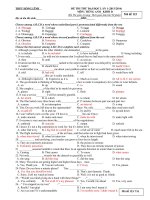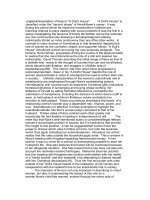2014-elzine-braasch-optimising-row-house-orientation
Bạn đang xem bản rút gọn của tài liệu. Xem và tải ngay bản đầy đủ của tài liệu tại đây (1.11 MB, 8 trang )
DESIGN RESEARCH: OPTIMISING ROW-HOUSE ORIENTATION
Michael Donn1, Elzine Braasch1, Marc Woodbury2, Evzen Novak2, Andrew Banks2
1
Victoria University of Wellington, New Zealand;
2
Studio of Pacific Architecture, Wellington, New Zealand
ABSTRACT
A collaborative research study of modular terrace
houses in Auckland, New Zealand has sought to find
optimal building orientation, faỗade design and layout
to inform the master plan for a housing development.
Two terrace house modules of different size within a
large multi-unit development were analysed.
EnergyPlus models were based on the preliminary
design concepts with sufficient zones that the thermal
performance of each functional space within the
terrace house could be studied. The smaller terrace
house had the greatest difference in performance
between best and worst orientations. Further
investigation determined that the major determinant of
this difference was neither size, nor plan layout of the
buildings but was the larger imbalance in window to
wall ratios of the two exposed facades.
INTRODUCTION
The city of Auckland, New Zealand’s largest urban
centre, aims to create a city where “…all people can
enjoy a high quality of life and improved standards of
living…” (Auckland Council, 2015). However, like all
urbanised cities in the world, Auckland is
experiencing a rapid upturn in population due to
natural increase and migration (Auckland Council,
2015). The Auckland Council predicts the population
of Auckland to increase by 1 million over the next 30
years. In an attempt to manage the natural and physical
resources of the country while enabling growth and
economic development, Auckland City Council has
proposed the Unitary Plan to help implement the
Auckland Plan (Auckland Council, 2013).
For the Environmentally Sustainable Design (ESD)
award winning architecture firm Studio Pacific
Architecture (SPA), the proposal of this new plan,
which strives for sustainable growth, calls for the need
to further improve their understanding of ESD to
design high quality medium-density housing within
Auckland (Studio Pacific Architecture, 2015).
Previous studies done on improving thermal
performance of new houses by SPA in collaboration
with Centre for Building Performance Research at
Victoria University of Wellington (CBPR) were
useful. They had identified for the firm the importance
of insulation, window size and orientation in the
design of stand-alone houses (Sullivan, Novak, &
Donn, 2012). However in working on a master plan
design for terrace housing in Auckland the question of
orientation of the maximum two external faces
became the focus of a supplementary study. The
orientation of the streets and thus the orientation of the
terrace houses and their effect on thermal performance
once again became a focus of a joint SPA/CBPR
study.
The overall aim of this study was to determine the
effect of orientation on the thermal performance of
terrace houses designed by Studio Pacific
Architecture. As with all studies of this type, the issue
of creating a ‘representative’ building for the
parametric study of orientation was a critical first step.
Rather than generic simplified modules the decision
was made to focus on actual SPA terrace house
designs within Auckland’s mild climate. As can be
seen in Figure 1, almost no hours in the year are
outside the zone where sensible passive solar design
could maintain comfort.
Figure 1 Climate Consultant (UCLA) Psychrometric chart of the
Auckland TMY File: Blue are Summer (Right) and Winter (Left)
comfort zones; Pink dotted lines shows Zone where Passive Solar
can heat the building; Green where Natural Ventilation can cool.
This study primarily focused upon the design of these
terrace houses within Auckland’s mild climate to
evaluate the design implications of only relying upon
common ‘rules of thumb’. As Auckland’ climate is
Figure 2 Plan view indicating zoning for the simplified model for Type A and B Terrace House
relatively warmer than other regions within New
Zealand, it was hypothesised that the terrace houses
would suffer from overheating due to the simple
reliance on a ‘rule of thumb’ for daylighting – larger
windows to the north would allow more penetration of
light. With terrace houses being limited to only two
exposed facades, the penetration of light was a key
design aim.
A weather file produced by NIWA for Auckland was
used within this study to provide climate data to test
the models within a mild climate.
It was thought that the glazing levels on the external
faces, and the internal plans and the size of plans might
have a significant effect on the results. The focus of
this project was on two of these three issues. Two
different modules of the terrace house buildings in
sketch design in the Studio Pacific Architecture
offices were compared and analysed within the energy
performance modelling program, EnergyPlus, to
determine the effectiveness of size, modularity and the
effect of orientation on specific layouts.
BACKGROUND
For stand-alone housing, the design of a master plan
of the streets in which it sits has less significance to
the thermal performance of the house design so long
as the layout of the house can be orientated with
minimal dependency on the orientation of the road. It
is in the nature of terrace/row housing, with party
walls separating the dwellings, that they are
commonly restricted by the orientation of the roads in
medium-density housing. Where an architecture
practice like SPA is keen to improve the sustainability
and hence thermal performance of their buildings, this
dependency will have a large impact on master
planning if the orientation of the road, and therefore
the terrace house, is shown to have a large impact on
the thermal performance of the house. Unfortunately,
no standard passive performance guideline exists for
terrace houses in New Zealand, nor can the currently
published standard ‘rules of thumb’ developed for
stand-alone houses be trusted for terrace house design.
Furthermore, the layout plan of the house is heavily
dependent on the exposed facades for access to natural
lighting and ventilation to most commonly used areas
such as the bedroom and living room. These
complexities, and the previous experience with
analysis of 9 of their stand-alone designs (Sullivan,
Novak, & Donn, 2012) encouraged SPA to conduct a
preliminary study through simulation .
THE TWO TERRACE HOUSES
The EnergyPlus models used within the study were
simplified from the preliminary design of the terrace
house buildings supplied by Studio Pacific
Architecture. The models were divided into several
zones, with the intent of determining how each
functional space within the terrace house would
perform thermally. These zones are illustrated in
Figure 2.
To test accurately the effect of orientation on the
terrace house’s thermal performance, each terrace
house was modelled and simulated in between two
similar terrace houses. The goal was to ensure that the
effects of the thermal properties of the thermal mass in
the party walls between each house were accounted
for as accurately as possible.
Each module is modelled and simulated firstly as
illustrated in Figures 3 and 4 to determine the effect of
the rows in orientation for master planning, assuming
that road grids within master planning can be changed.
These modules were then modelled and simulated as a
row where each terrace house was individually
orientated to determine the effect of orientation in
master planning, assuming that the road grids within
master planning cannot be altered.
Within this process of modelling, the configuration of
how the terrace houses are connected to each other
was tested. For example, Type B’s terrace house
configuration was set out where the houses mirror
each other, rather than being copied next to each other
as was the case in Type A’s configuration.
Figure 3 Diagram showing
configuration of Type A
terrace houses
Figure 4 Diagram showing
configuration of Type B
terrace houses
However, in individually rotating the terrace houses,
Type B might no longer be rows of terrace houses at a
certain degree angle. Figure 5 and 6 illustrate how
each terrace house was modelled in their
configuration.
Figure 6 Diagram showing how each individual terrace house
was spun for the Type B terrace house
To observe the sensitivities of orientations, the models
were simulated with ideal loads in analysed rooms –
kitchen and bedrooms – with heat pumps within the
living rooms. To analyse the effect of orientation on
each terrace house module, each house was modelled
with the same parameters, construction types and
lighting equipment – and was simulated at varying
orientations. The construction of both module terrace
houses was a mixture of masonry and timber
construction designed to have R-values 50% above the
building code requirements. All modelling parameter
inputs were identical for simulation runs, with the
orientation being the only parameter changed.
Internal loads were scheduled to represent working
professionals at home to test the “worst” scenario. In
simulating the worst-case scenario for internal heat
gains, the maximum effect of orientation can be
determined. These simulations process data outputs,
which represent the total energy use if the rooms were
to be heated and cooled to comfortable temperatures.
The chosen best and worst orientations were further
simulated without any heating or cooling to represent
the real house in order to determine how well the
terrace house would perform passively.
ANALYSING PERFORMANCE
Energy
For the purposes of understanding the effect of
orientation on the thermal performance of the
building, heating and cooling at 18°C -25°C set points
were used to analyse the sensitivity of the different
orientations.
No energy performance comparisons were made
between modules as their comparison was not the
subject of this study.
Figure 5 Diagram showing how each individual terrace house
was spun for the Type A terrace house
Comfort Hours
Comfort hours were represented as a percentage of
how many hours of the year the space will be
comfortable. The temperatures for the entire day were
separated between the hours of 7am-7pm for day
readings, and from 8pm-6am for night readings.
Morning temperatures were also analysed between the
hours of 6am-8am. The quality of the space in terms
of temperature is often related to the measure of
“thermal comfort”, or level of “satisfaction” felt by the
building occupants. For the purposes of this study,
“thermal comfort” was defined between the ranges of
18-25°C.
Analysis of the comfort hours for each simulated
model was represented in a stack bar graph, with the
categories of:
Less than 18°C, represented as blue
Between 18°C-25°C, represented as green
Greater than 25°C, represented as red
The hottest peak day, 21st February, and the coldest
peak day, 21st July, were analysed to determine how
well the terrace building would perform on the worse
days for heating or cooling. The values for this
analysis were also given as a percentage for thermal
comfort hours.
RESULTS
The following parameters and model configurations
were tested:
Bar Orientation: A row of three terrace
houses orientated relative to each other
Individual Orientation: Each individual
terrace house was orientated separately along
a set road direction to maximum of 45° - all
orientations were tested where the road
orientation was changed along with the
individual terrace house orientation
In 5° steps, little difference was found between
individual orientations. The terrace houses were
individually orientated and tested in 15° steps.
Type A
was similar for all tested methods of orientating the
building, including separating the terrace house from
its neighbours by a 1 metre gap to make it a standalone house. Indicated in Figure 7 as “K”, the best
orientation locates the kitchen to the North. This
placement was ill advisable as the kitchen has the
largest equipment loads contributing to the most
internal heat gains when in operation. However, the
kitchen within Type A performed well facing north
due to the open-plan configuration with the
surrounding rooms, allowing most of the internal heat
to be distributed throughout the ground floor. The
kitchen was scheduled to operate for a few hours in the
early evening.
The worst orientation indicated in Figure 7 occurred
when the largest window area faced to the west
afternoon sun. In comparing the commonalities
between these two findings, it was clear that the
building performed poorly where large window areas
face towards the North and West.
The differences between the various orientations were
minimal, with a maximum 7% difference between the
best and worst orientations found.
In analysing comfort hour temperatures, the
performance of the terrace house on the hottest day
illustrated by Figure 8 was poor during the day.
Between the hours of 7am-7pm, the terrace house was
comfortable less than 40% of the time. In orientating
the largest window away from the North, the comfort
hours during the day increased but not dramatically. In
this case, the alterations of natural ventilation and
insulation design options made a greater difference in
increasing comfort hours. Facing the largest window
away from the sun resulted in the best performance on
the hottest and coldest day of the year, illustrated in
Figures 8 and 9, and performed best on average across
the whole year. This indicated that the designs of SPA
for Type A had overheating issues from over-exposure
to the sun and lack of cross ventilation.
These results indicated that reduction of solar
penetration is required, particularly during the
summer. This was observed where the largest Window
to Wall Ratio (WWR) is best orientated away from
exposure to the sun.
0
The Type A terrace house has an optimal orientation
at 180° from its current design, orientating the larger
window area to the south and exposing a smaller
window area to the North. This optimal orientation
180
90%
75%
79%
40%
90%
78%
Figure 7 Best and worst orientation for the Type A terrace
house, where K indicates the location of the kitchen in plan and
B indicates the bedrooms in plan.
36%
Morning (6am‐8am)
33%
Night (8pm‐6am)
90%
Day (7am‐7pm)
285
Figure 8 Comparison of Average Comfort Hour Temperature
Percentages of Different Orientations on the Hottest Day of the
year (21st Feb) for Type A terrace house
Day (7am‐7pm)
Night (8pm‐6am)
0
180
100%
95%
90%
100%
97%
95%
90%
84%
79%
Morning (6am‐8am)
The differences between the various orientations were
minimal, with only a 5% difference between the best
and worst orientations.
285
Figure 9 Comparison of Average Comfort Hour Temperature
Percentages of Different Orientations on the Coldest Day of the
year (21st July) for Type A terrace house
180
87%
84%
87%
77%
75%
0
59%
69%
Morning (6am‐8am)
71%
Night (8pm‐6am)
89%
Day (7am‐7pm)
indicating that the issue with the current design is
overheating from solar gains. The worst orientation
was found to be around 270°, where the largest WWR
is faced towards the western afternoon sun.
285
Figure 10 Comparison of Average Comfort Hour Temperature
Percentages of Different Orientations for Type A Terrace House
Type B
This result corresponds to the same result found with
Type A, suggesting that the module size and layout
has little to no effect on which orientation is optimal.
However, the kitchen layout is significantly different
to Type A. It is connected to the other areas of the
ground floor by a small opening – a door. The rate of
distribution of heat from the kitchen is therefore
significantly reduced and may contribute to the
reasons why it performed best orientated away from
the North. In analysing comfort hour temperatures, the
best orientation for overall energy consumption, 180°
from North, also performed the best on the hottest and
coldest day of the year. Similarly, the terrace house
performed best thermally on average across the year at
180° - away from the sun- as is shown in Figure 14.
Type B’s coldest day results shown in Figure 13
compared to Type A’s coldest day results shown in
Figure 9 demonstrate the difference between the two
modules. Where Type A’s thermal performance was
reasonably good during the winter, Type B was too
cold during the night and early mornings. As Type B
had a greater total surface area exposed to the outside,
and contained an unheated garage modelled against
the building envelope of the house, heat loss may be a
contributing factor.
Day (7am‐7pm)
Night (8pm‐6am)
The Type B terrace house was optimal when flipped
180° from its planned orientation. For Type B, the
worst orientation was significantly different for the
individually orientated building, as illustrated in the
summary diagram Figure 11. Due to the method of
individually orientating the buildings, a greater
surface area was exposed to the outside causing a
larger overall heat loss through the exposed walls. In
this case, the amount of heat loss dominated the effect
of the orientation of the largest WWR.
In the case for the optimal orientation, the kitchen is
no longer located north but rather newly located
towards the South. Similarly to Type A, the larger
WWR was no longer faced towards the north,
120
100%
100%
53%
100%
100%
100%
64%
56%
Figure 11 Best and worst orientation for the Type B terrace
house, where K indicates the location of the kitchen in plan and
B indicates the bedrooms in plan.
100%
Morning (6am‐8am)
180
270
Figure 12 Comparison of Average Comfort Hour Temperature
Percentages of Different Orientations on the Hottest Day of the
Year (21st Feb) For Type C Terrace House
Night (8pm‐6am)
kWh per year
Day (7am‐7pm)
65%
180
270
Figure 13 Comparison of Average Comfort Hour Temperature
Percentages of Different Orientations on the Coldest Day of the
Year (21st July) For Type C Terrace House
180
64%
61%
76%
85%
75%
120
59%
69%
Morning (6am‐8am)
77%
Night (8pm‐6am)
83%
Day (7am‐7pm)
270
Figure 14 Comparison of Average Comfort Hour Temperature
Percentages of Different Orientations for Type C Terrace House
FURTHER ANALYSIS
Type A
The Type A terrace house was designed with an
average of 48% Window to Wall Ratio (WWR) on the
northern end, and 19% WWR on the southern end.
Due to the large amount of glazing on the northern
side, it is not surprising that the building would
operate better when rotated 180°. As the building’s
largest issue was overheating, the fact that a large
value is facing south is not an issue, as the insulation
of the windows prove to work well against the
potential heat loss through the glazing on the southern
end. This suggested that the WWR on the northern end
could be reduced for improved thermal performance.
If the WWR were to be reduced to 10%, would that
make an effect on orientation?
With both ends of the terrace house designed having a
WWR of 10%, Figure 15 illustrates that the
differences in orientation were hardly noticeable. The
best and worst orientations have a difference of less
than 1%, indicating that the size of the windows had
the greatest impact on how orientation might affect the
thermal performance of the building. The difference
between the reference model, with the specified WWR
for Type A terrace house, and the modified terrace
house with a 10% WWR was 5% however this did not
make a significant reduction in energy consumption.
In reducing the WWR, cooling was reduced by 15%
due to a reduction in solar gains through the glazing.
Figure 15 Comparison of the Bar Orientation of Type A Terrace
House Total Energy Use in 45° step stages from True North, 0,
with 10% WWR on both ends of the terrace house
Type B
Similarly to Type A, the Type B terrace house was
designed with a large WWR, with a maximum of 50%
on the northern end and 19% on the southern end. As
already noted, the Type B terrace house performed
best with its northern end facing south. The large size
of the WWR on the northern end was causing it to
overheat to the point where it performed best faced in
a direction which would minimise solar gains. To
further understand this, the terrace house windows
were changed to have a 10% WWR.
After modifying the WWR, orientation made no real
difference to total energy consumption, demonstrated
in Figure 16. Similarly to Type A, the reduction in
window area decreased the amount of cooling and
increased the heating required to maintain a
comfortable temperature range. Best and worst
orientations found for Type B have not changed.
However, the reduction in WWR in Type C makes a
small 2% difference to overall total energy
consumption due to the large proportion of energy
used for equipment, rather than for heating and
cooling.
kWh per year
120
0%
0%
20%
24%
0%
17%
56%
69%
Morning (6am‐8am)
10000
8000
6000
4000
2000
0
10000
8000
6000
4000
2000
0
Figure 16 Comparison of the Bar Orientation of Type C Terrace
House Total Energy Use in 45° step stages from True North, 0,
with 10% WWR on both ends of the terrace house
DISCUSSION
The results from both terrace houses suggest the same
conclusions, despite the various differences in layout
and size. In both terrace house modules, the thermal
performance was greatly affected by the size of the
glazing on each faỗade. Both modules were designed
with large Window to Wall Ratios (WWR) on the
northern facades to allow for natural lighting. Due to
this design choice, both modules performed better
when these windows were orientated away from full
solar exposure.
The layout differences were only significant when
considering the kitchen connection to other spaces on
the ground floor. Type B’s kitchen temperatures rose
much higher than those of Type A’s when they were
both facing north due to the small connection to the
living room from the one door. The solar gains
gathered within the kitchen, coupled with the high
internal heat gains from the oven and other appliances,
needed to be distributed to the other areas for optimal
comfort. From this observation, it was suggested to
SPA that high internal heat gain utility areas such as
the kitchen should be connected to the other areas in
open plan. In this configuration, as demonstrated by
Type A, the layout should have little effect on thermal
performance when orientation is considered.
The concluding result in further analysis with the
window glazing alterations coupled with orientation is
specifically significant in this study. Where both
WWR of the two facades were brought down to 10%,
the reduction in solar penetration and heat loss made
the effect of orientation negligible. Further testing,
bringing the WWR of both to 20% produced the same
results (of no difference in thermal performance for
the varying orientations). This suggests that equal
faỗade WWR eliminates the need for optimal
orientation considerations. This result is further
emphasised by comparing the maximum effect
orientation can have on the energy performance of the
two module terrace houses. Type A had the greatest
difference in orientation between best and worst
compared to Type B primarily due to the large
imbalance of WWR of the two facades. Type A has a
WWR difference of 21% between the two facades,
whereas Type B had a difference of 11%.
This finding at first glance suggests that orientation
can be neglected when designing for optimal passive
performance of row houses. It is clear from these
results that orientation will make a larger impact on
the design if WWR differences between the two
exposed facades is large when in Auckland. Making
the leap to suggesting that North, South, East or West
orientations are of equal thermal value for all row
houses in New Zealand seems premature.
Quality Assurance
A significant proportion of the design analysis was
spent in Quality Assurance measures to ensure the
exercise produced robust results. The sensitivity
analysis of a variety of different parameters within the
model was performed to establish which factors have
the greatest effect upon the results, thereby narrowing
the focus on the accuracy of the parameter itself. Such
variations included:
Altering the kitchen appliance scheduling
Altering daily scheduling
Altering construction types
Adding adjacent terrace house buildings
Adding concrete slab edges
These were compared to a reference model with full
ideal loads operating in order to better understand their
effect on the temperatures within every room.
As a result special consideration was given to
scheduling and equipment loads to ensure an accurate
and realistic reading of the simulated model. Tests of
the shading of other rows of houses were shown in the
same exercise to cause less than 2% difference in total
energy consumption.
CONCLUSION
Orientation has a less than 10% effect on the energy
performance of these terrace houses in the Auckland
climate. As the energy required for both cooling and
heating were originally minimal due to the higher than
minimum code insulation techniques and window
technology implemented, the differences between best
and worst orientations resulted in a tiny difference in
energy costs. The greatest source of energy
consumption and heat gains came from behavioural
usage of the equipment specified within the house.
Implications towards Current Design Practice
The implications of these findings towards current
design practice, and the use of simulation in current
practice, are significant. The results convincingly
demonstrate that when varying only orientation in row
houses, in Auckland there is likely very little effect on
the performance of a well-insulated terrace house
building if the high performance windows have the
same Window to Wall Ratio (WWR) on both ends of
the terrace house. These results are consistent with the
findings of most passive design studies for stand-alone
houses such as “Designing Comfortable Homes”
(Donn & Thomas, 2010). Passive Solar Design to
work best requires careful maximising of windows
facing North, careful shading for summer, and high
performance building fabric.
The issue identified in this study was that a terrace
house interior layout makes it difficult to design for
optimal solar performance using only “rules of thumb”
for orientation and placement of ‘warm’ living spaces
facing North and ‘cool’ utility spaces facing South.
Exposure to sunlight is limited to the windows on the
ends of the house. Asymmetry of WWR has been
shown to have the expected large impact on how
orientation can affect the performance of the terrace
house.
The conclusion drawn for Studio Pacific Architecture
from this study was the need for the terrace house
design teams to focus carefully on window sizing,
window placement and orientation in relation to the
internal planning of each house. Orientation alone
cannot guarantee good passive performance. In fact, in
the mild Auckland environment, local overheating of
individual rooms no matter which way the building
faces may be more of an issue for the people in the
building than the energy costs of comfort.
ACKNOWLEDGEMENT
This study would not have been done without the
support, access to design work and help which Studio
Pacific Architecture offered to this project. The
supervisors from both SPA and CBPR have been
invaluable for this study.
REFERENCES
Auckland Council. (2013). Proposed Auckland
Unitary Plan. Retrieved 10 May 2015, from
/>nspoliciesprojects/plansstrategies/unitarypla
n/Pages/home.aspx?utm_source=shorturl&u
tm_medium=print&utm_campaign=Unitary
_Plan
Auckland Council. (2015). Auckland Now and Into
The Future. Retrieved 10 May 2015, from
/>and-now-and-into-the-future/
Donn, M., & Thomas, G. (2010). Designing
Comfortable Homes (2nd ed.). Wellington:
Cement & Concrete Association of New
Zealand.
Studio Pacific Architecture. (2015). Studio Pacific
Architecture. Retrieved 10 May 2015, from
Sullivan, J., Novak, E., & Donn, M. (2012). Thermal
performance modelling: design strategies for
improved thermal performance in selected
NZ houses. Presented at the ANZAScA
Conference, Gold Coast, Queensland,
Australia. Retrieved 10 May 2015, from
/>f
UCLA Climate Consultant Software (2015).
Retrieved 10 May 2015, from
/>









